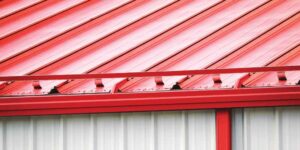
Snow retention is a critical component to consider when installing a metal roof. But what is the best type of snow guard to keep snow from falling off the roof and wreaking havoc? This decision will be based on the type of roof panel or, perhaps, the type of look wanted. There are many configurations of snow guards on the market, but individual pad-style snow guards and continuous rail-type snow guards are the two most used in the U.S. Both can be installed through fastened panels and standing seam panels.
Individual snow guards will adhere to the roof panel either by adhesive or sealant, or by fasteners that penetrate through the roof panel into the structural substrate. However, these pad-style snow guards are typically manufactured from polycarbonate and do not usually offer the same strength characteristics of a continuous rail system.
Continuous rail-type snow guards will attach either by a mount that is through-fastened into a structural member, for corrugated or through-fastened panels, or by clamps that will attach to the seam of a standing seam panel, using non-penetrating set screws. Either of these two methods will then use a continuous rail or extrusion that attaches to either the mount or the clamps and will also have a flag that hangs down and rests in the center of the flat of the panel; this will keep snow and ice from sliding under the snow guards. Without this flag, any snow and or ice buildup would be free to release from the roof. Potentially causing property or pedestrian damage below.
Rail-type snow guards are commonly manufactured from aircraft-quality, high-tensile aluminum and use stainless steel set screws and hex bolts for attaching.
Both pad-style and rail-type snow guards offer the option to match the color of the roof panels. Preferred systems will use flat stock panels that have been cut down to slide in the face of the rail or extrusion. This will ensure roofline aesthetics for many years as the color of the snow guards will not fade at a different rate than that of the panels.
One issue to consider with snow guards is whether the system has been independently tested and if the system can be designed and engineered for the specific roof. Generically speaking, most continuous rail-type snow retention systems will be installed in a single row within a few feet of the eave line; individual pad-style snow guards will be installed in a grid or staggered pattern. In certain circumstances, multiple rows will be required to properly retain the accumulating snow no matter which system is used. Rail-type systems are more likely to use a single row due to the greater holding power versus the glue-down pad style. Panel length and roof slope are two factors that play into calculating whether multiple rows are needed. There are other factors that need to be considered: designed roof snow loads and the roof panel base material, width, and configuration. Always consult with the snow guard manufacturer for engineering and calculations for each individual roof.
Further, a clean roof panel surface and proper installation of any style of snow retention system are imperative. Individual pad-style snow guards rely on adhesive or sealant for attachment in optimum weather conditions. These adhesives or sealants are recommended to be installed at temperatures above 4.5 C (40 F) for application and require seven to 14 days to fully cure.
Continuous rail-type snow guards can be installed in virtually any weather conditions. However, choosing the correct clamp for the roof panel configuration is essential, and clamp set screw torque is a critical component in the strength of a continuous rail system. Using a calibrated torque wrench to tension the set screws properly is necessary, as is alternately tightening the set screws repeatedly until they all hold the required tension during installation. Manufacturers should be able to provide clamp- and panel-specific torque values. Consult with the manufacturer before installation for the recommended materials, tools, and procedures.
Sliding of snow and ice accumulation on unprotected metal roofs can cause issues such as property damage and potential physical injury to individuals. Using the properly engineered and tested snow retention system can alleviate these dangers.
Jerod Webber is sales manager at Dynamic Fastener. He has been in the metal building industry for 20-plus years and is one of the company’s snow retention experts.


